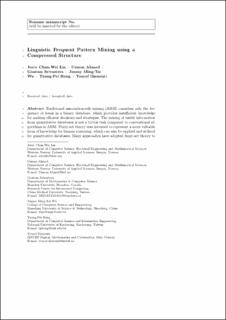| dc.contributor.author | Lin, Jerry Chun-Wei | |
| dc.contributor.author | Ahmed, Usman | |
| dc.contributor.author | Srivastava, Gautam | |
| dc.contributor.author | Wu, Jimmy Ming-Tai | |
| dc.contributor.author | Hong, Tzung-Pei | |
| dc.contributor.author | Djenouri, Youcef | |
| dc.date.accessioned | 2022-03-15T09:59:34Z | |
| dc.date.available | 2022-03-15T09:59:34Z | |
| dc.date.created | 2021-04-18T12:08:38Z | |
| dc.date.issued | 2021 | |
| dc.identifier.citation | Lin, J. C.-W., Ahmed, U., Srivastava, G., Wu, J. M.-T., Hong, T.-P. & Djenouri, Y. (2021). Linguistic frequent pattern mining using a compressed structure. Applied Intelligence, 51(7), 4806-4823. | en_US |
| dc.identifier.issn | 0924-669X | |
| dc.identifier.uri | https://hdl.handle.net/11250/2985206 | |
| dc.description | This is a preprint. The version of record of this article, first published in Applied Intelligence, is available online at Publisher’s website: https://doi.org/10.1007/s10489-020-02080-w | en_US |
| dc.description.abstract | Traditional association-rule mining (ARM) considers only the frequency of items in a binary database, which provides insufficient knowledge for making efficient decisions and strategies. The mining of useful information from quantitative databases is not a trivial task compared to conventional algorithms in ARM. Fuzzy-set theory was invented to represent a more valuable form of knowledge for human reasoning, which can also be applied and utilized for quantitative databases. Many approaches have adopted fuzzy-set theory to transform the quantitative value into linguistic terms with its corresponding degree based on defined membership functions for the discovery of FFIs, also known as fuzzy frequent itemsets. Only linguistic terms with maximal scalar cardinality are considered in traditional fuzzy frequent itemset mining, but the uncertainty factor is not involved in past approaches. In this paper, an efficient fuzzy mining (EFM) algorithm is presented to quickly discover multiple FFIs from quantitative databases under type-2 fuzzy-set theory. A compressed fuzzy-list (CFL)-structure is developed to maintain complete information for rule generation. Two pruning techniques are developed for reducing the search space and speeding up the mining process. Several experiments are carried out to verify the efficiency and effectiveness of the designed approach in terms of runtime, the number of examined nodes, memory usage, and scalability under different minimum support thresholds and different linguistic terms used in the membership functions. | en_US |
| dc.language.iso | eng | en_US |
| dc.publisher | Springer | en_US |
| dc.subject | fuzzy-set theory | en_US |
| dc.subject | fuzzy data mining | en_US |
| dc.subject | fuzzy-list structure | en_US |
| dc.subject | pruning strategies | en_US |
| dc.title | Linguistic frequent pattern mining using a compressed structure | en_US |
| dc.type | Peer reviewed | en_US |
| dc.type | Journal article | en_US |
| dc.description.version | submittedVersion | en_US |
| dc.subject.nsi | VDP::Matematikk og Naturvitenskap: 400::Informasjons- og kommunikasjonsvitenskap: 420 | en_US |
| dc.source.pagenumber | 4806-4823 | en_US |
| dc.source.volume | 51 | en_US |
| dc.source.journal | Applied intelligence (Boston) | en_US |
| dc.identifier.doi | 10.1007/s10489-020-02080-w | |
| dc.identifier.cristin | 1904878 | |
| cristin.ispublished | true | |
| cristin.fulltext | preprint | |
| cristin.qualitycode | 2 | |
